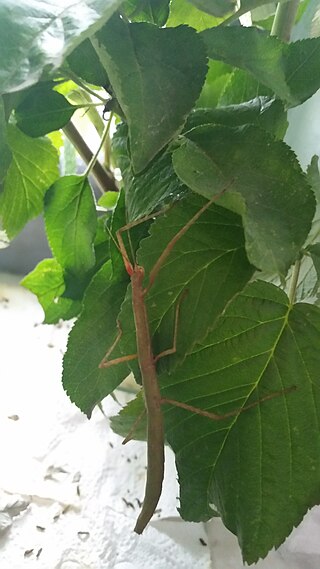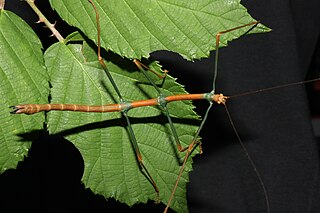
Carausius is a genus of the tribe Lonchodini, in the order Phasmatodea. The genus is in many ways typical of the Phasmatodea in that all species are twig-like in appearance. These species are parthenogenetic.

The Phaneropterinae, the sickle-bearing bush crickets or leaf katydids, are a subfamily of insects within the family Tettigoniidae. Nearly 2,060 species in 85 genera throughout the world are known. They are also known as false katydids or round-headed katydids.

Lonchodes is a genus of stick insects in the family Phasmatidae and the type genus of the family Lonchodidae and tribe Lonchodini. Species have a known distribution that includes tropical Asia and the Pacific.

Ramulus is an Asian genus of stick insects in the family Phasmatidae and tribe Clitumnini.
Paraprisomera coronata, is a species of phasmid or stick insect of the genus Paraprisomera. It is found in Sri Lanka.
Cuniculina obnoxia, is a species of phasmid or stick insect of the genus Cuniculina. It is found in Sri Lanka.
Lonchodes femoralis, is a species of phasmid or stick insect found in Sri Lanka.
Prisomera spinosissimum is a species of phasmid or stick insect of the genus Prisomera. It is found in India, Sri Lanka and Malaysia.
Ramulus ablutus, is a species of phasmid or stick insect of the genus Ramulus. It is found in Sri Lanka.
Ramulus lineaticeps is a species of phasmid or stick insect. It is found in Sri Lanka.
Ramulus lobulatus is a species of phasmid or stick insect. It is found in Sri Lanka.
Ramulus trilineatus is a species of phasmid or stick insect. It is found in Sri Lanka.

The Clitumninae are a sub-family of stick insects in the family Phasmatidae found in Asia. The type genus Clitumnus is now considered a synonym of Ramulus.

The Lonchodinae are a subfamily of stick insects in the family Lonchodidae found in: Australasia, Asia, Africa, Southern America and the Pacific.
Medauromorpha is an Asian genus of stick insects in the family Phasmatidae, subfamily Clitumninae and tribe Medaurini. Species have a known distribution from Vietnam and southern China.

The Platycraninae are an anareolate subfamily of stick insects in the family Phasmatidae. Their known distribution includes southern, southeast Asia and Australasia.
Prisomera is a genus of phasmids belonging to the family Lonchodidae.
Rhamphophasma is a genus of stick insects in the tribe Clitumnini, erected by Carl Brunner von Wattenwyl in 1893. Species have been recorded from: China, Vietnam, India, Myanmar and Japan.
Prosentoria is a genus of stick insects in the tribe Clitumnini, erected by Carl Brunner von Wattenwyl in 1907. Species have been recorded from: Vietnam and Borneo.

Parapachymorpha is a genus of stick insects in the tribe Medaurini, erected by Carl Brunner von Wattenwyl in 1893. Species have been recorded from: China, Myanmar, Thailand, Cambodia and Vietnam.







